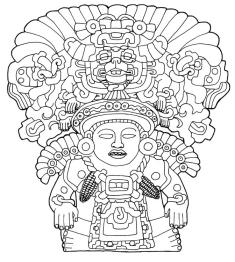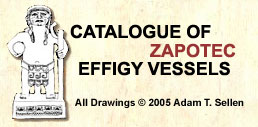| Key: MDO 32 | | Actual Location: Dolores Olmedo Museum, Mexico City, México (exhibited). | | Collection: Fernando Sologuren; Armilia Van Rijn (195?-1964); Dolores Olmedo Patiño (presently). | | Registration: Record from the National Anthropology and History Institute (INAH) , P.F. 100, LO 32 | | Provenance: Probably Etla, Oaxaca | | Measurements: 51 x 46 cm. | | Color: Dark grey clay | | Chronology: Pitao 350 - 500 AD | | Click to view Chronology | | Reference: Caso & Bernal 1952: 98, fig. 163; Boos 1966b: 65; 50-peso bill circa 1973; Eubanks 1999: 137-138, fig. 110; Sellen 2002: 9, fig. 5e y 11, fig. 8. | | Comments: This piece was probably found by Fernando Sologuren at the beginning of last century. In 1928, Caso and Bernal (1952: 97) took pictures of the piece when it was at Mercedes Sologuren's house. At the beginning of the 1950s, the piece went to Machida Armilia Van Rijn and then, in 1964, it was acquired by Dolores Olmedo Patiño (personal communication Patricia Van Rijn, 1999). For other types, see MNA 6-635, cm.A 44.78, MFVV 55.158, EMB 24882 and MFR s/n 1. For an analysis of this type, see Sellen 2002: 9. For the same Etla style, see MDO 33 and MFR 12619. | | Glyphs: Glyph C in the headdress flanked by two glyphs of small plants and then, two glyphs for corn. The figure in the headdress corresponds to the Cocijo (glyph M). | |
| | 
Click to view high resolution in a new window
select this image for review |
